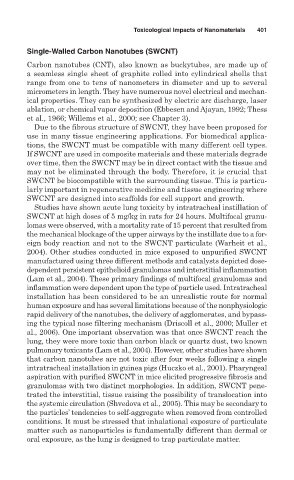Page 418 - Environmental Nanotechnology Applications and Impacts of Nanomaterials
P. 418
Toxicological Impacts of Nanomaterials 401
Single-Walled Carbon Nanotubes (SWCNT)
Carbon nanotubes (CNT), also known as buckytubes, are made up of
a seamless single sheet of graphite rolled into cylindrical shells that
range from one to tens of nanometers in diameter and up to several
micrometers in length. They have numerous novel electrical and mechan-
ical properties. They can be synthesized by electric arc discharge, laser
ablation, or chemical vapor deposition (Ebbesen and Ajayan, 1992; Thess
et al., 1966; Willems et al., 2000; see Chapter 3).
Due to the fibrous structure of SWCNT, they have been proposed for
use in many tissue engineering applications. For biomedical applica-
tions, the SWCNT must be compatible with many different cell types.
If SWCNT are used in composite materials and these materials degrade
over time, then the SWCNT may be in direct contact with the tissue and
may not be eliminated through the body. Therefore, it is crucial that
SWCNT be biocompatible with the surrounding tissue. This is particu-
larly important in regenerative medicine and tissue engineering where
SWCNT are designed into scaffolds for cell support and growth.
Studies have shown acute lung toxicity by intratracheal instillation of
SWCNT at high doses of 5 mg/kg in rats for 24 hours. Multifocal granu-
lomas were observed, with a mortality rate of 15 percent that resulted from
the mechanical blockage of the upper airways by the instillate due to a for-
eign body reaction and not to the SWCNT particulate (Warheit et al.,
2004). Other studies conducted in mice exposed to unpurified SWCNT
manufactured using three different methods and catalysts depicted dose-
dependent persistent epithelioid granulomas and interstitial inflammation
(Lam et al., 2004). These primary findings of multifocal granulomas and
inflammation were dependent upon the type of particle used. Intratracheal
installation has been considered to be an unrealistic route for normal
human exposure and has several limitations because of the nonphysiologic
rapid delivery of the nanotubes, the delivery of agglomerates, and bypass-
ing the typical nose filtering mechanism (Driscoll et al., 2000; Muller et
al., 2006). One important observation was that once SWCNT reach the
lung, they were more toxic than carbon black or quartz dust, two known
pulmonary toxicants (Lam et al., 2004). However, other studies have shown
that carbon nanotubes are not toxic after four weeks following a single
intratracheal installation in guinea pigs (Huczko et al., 2001). Pharyngeal
aspiration with purified SWCNT in mice elicited progressive fibrosis and
granulomas with two distinct morphologies. In addition, SWCNT pene-
trated the interstitial, tissue raising the possibility of translocation into
the systemic circulation (Shvedova et al., 2005). This may be secondary to
the particles’ tendencies to self-aggregate when removed from controlled
conditions. It must be stressed that inhalational exposure of particulate
matter such as nanoparticles is fundamentally different than dermal or
oral exposure, as the lung is designed to trap particulate matter.

